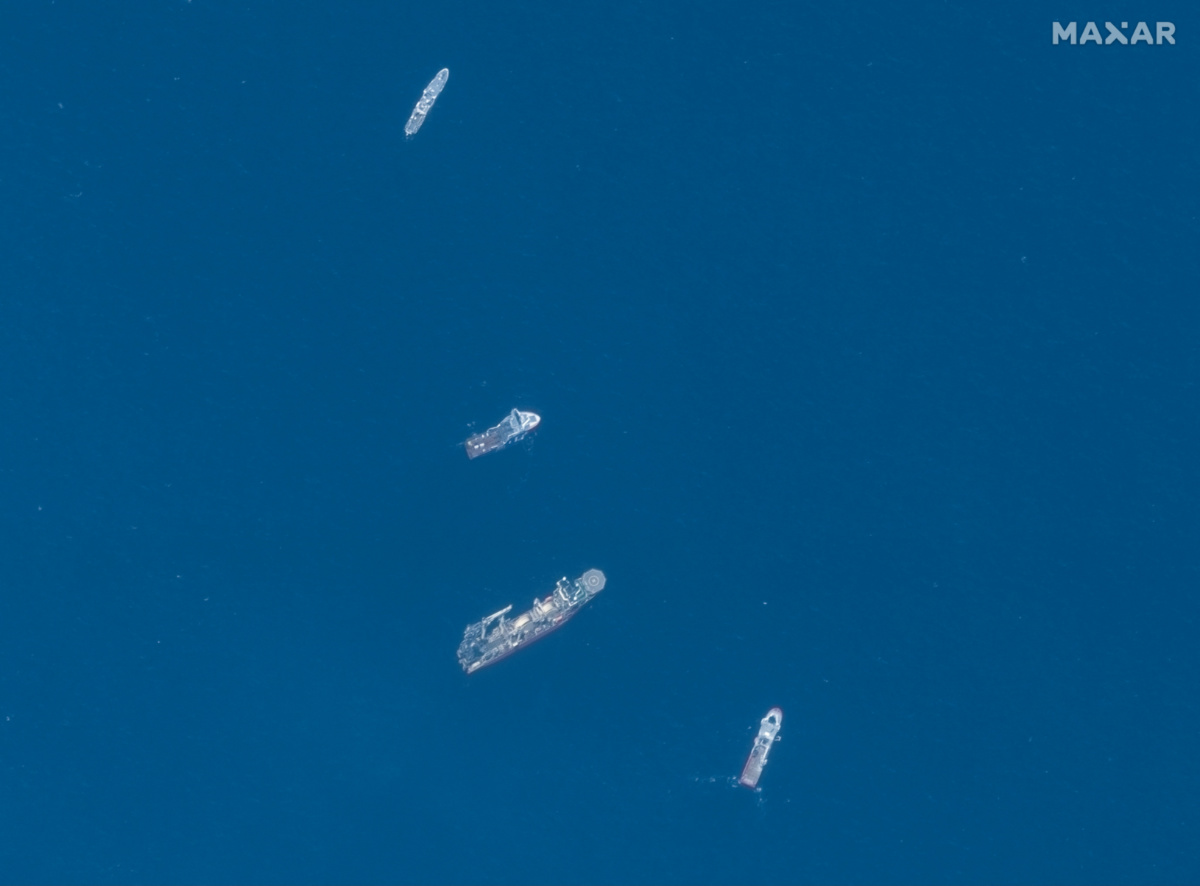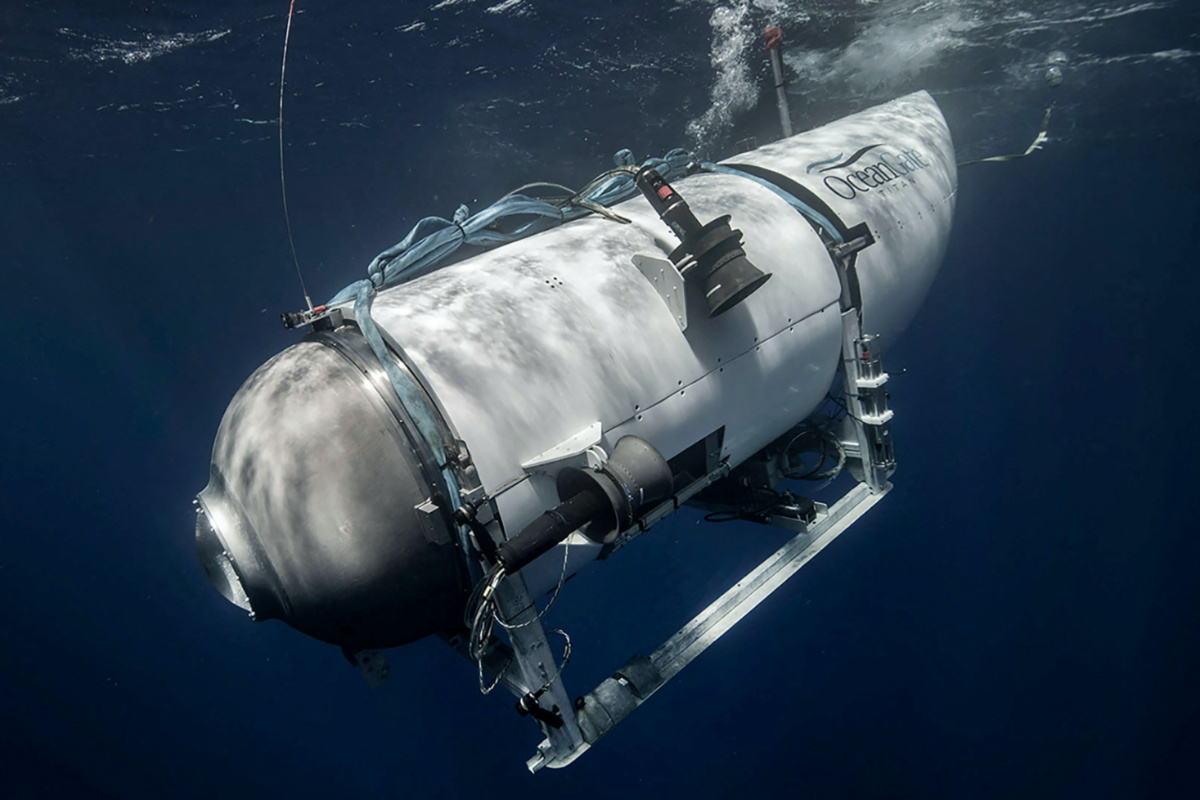Canadian Government regulators on Friday opened a safety investigation into the undersea implosion of a tourist submersible that killed all five people aboard during a voyage to the century-old wreck of the Titanic.
A debris field from the submersible Titan was found at the bottom of the North Atlantic on Thursday by a robotic diving vehicle deployed from a Canadian search vessel, ending an intense five-day international rescue effort.

A satellite image shows ships taking part in the search and rescue operations associated with the missing Titan submersible near the wreck of the Titanic, on 22nd June, 2023. PICTURE: Maxar Technologies/Handout via Reuters
Fragments of Titan, which lost contact with its surface support ship about one hour and 45 minutes into a two-hour descent on Sunday, were discovered on the seabed about 488 metres from the bow of the Titanic wreck, about four kilometres below the surface, US Coast Guard Rear Admiral John Mauger said.
He told reporters on Thursday the debris was consistent with “a catastrophic implosion of the vehicle”, meaning the 22-foot-long vessel ultimately collapsed and was crushed under the immense hydrostatic pressure at that depth.
The five who died included Stockton Rush, US founder and chief executive officer of OceanGate Expeditions, which operated the submersible and charged $US250,000 per person to make the Titanic trip. He was piloting the craft.
The others were British billionaire and explorer Hamish Harding, 58; Pakistani-born businessman Shahzada Dawood, 48, and his 19-year-old son, Suleman, both British citizens; and French oceanographer Paul-Henri Nargeolet, 77.
“These men were true explorers who shared a distinct spirit of adventure, and a deep passion for exploring and protecting the world’s oceans,” OceanGate said.
In a statement on Friday, Canada’s Transportation Safety Board said it was launching a “safety investigation regarding the circumstances of this operation” because Titan‘s surface support vessel, the Polar Prince, was a Canadian-flagged ship.
Guillermo Söhnlein, who co-founded OceanGate with Rush in 2009, said Rush was “keenly aware” of the dangers of exploring the ocean depths.
“Stockton was one of the most astute risk managers I’d ever met,” said Söhnlein, who left the company in 2013, retaining a minority stake. “He was very risk-averse.”
British Titanic explorer Dik Barton paid tribute to the work of his friend Nargeolet but noted issues raised with the design and maintenance of the craft.
“Everyone’s wise after the event, but as we’re hearing before, unfortunately there were many red flags flying here,” he said.
Questions about Titan’s safety were raised in 2018 during a symposium of submersible industry experts and in a lawsuit by OceanGate’s former head of marine operations, which was settled later that year.
Worldwide media coverage of the search riveted audiences and overshadowed the aftermath of a far greater disaster from the wreck of a migrant vessel off Greece last week that killed hundreds of people.

The Titan submersible, operated by OceanGate Expeditions to explore the wreckage of the sunken Titanic off the coast of Newfoundland, dives in an undated photograph. PICTURE: OceanGate Expeditions/Handout via Reuters
International effort
Teams from the US, Canada, France and Britain had spent days scanning a vast expanse of open sea for the Titan.
The US Coast Guard’s Mauger said it was too early to say when the Titan met its fate.
The position of debris relatively close to the wreck suggested it happened near the end of Sunday’s descent.
The US Navy monitors that part of the Atlantic for submarine activity, and said an analysis of acoustic data detected “an anomaly consistent with an implosion or explosion” near the submersible’s location when communication with Titan was lost.
The acoustic data was shared immediately with the unified command led by the US Coast Guard, according to Navy officials, who spoke on condition of anonymity. It was decided the acoustic data was not definitive and the search and rescue mission should continue.
One Navy official said that while it was not immediately clear what the cost to the Navy would be of the rescue effort, it was likely to be negligible.
Moviemaker James Cameron, who directed the 1997 Oscar-winning film Titanic that did much to revive global interest in the British ocean liner that sank in 1912, said he learned of the acoustic findings within a day of the submersible disappearing and knew what it meant.
“I sent emails to everybody I know and said we’ve lost some friends. The sub had imploded,” Cameron, who has ventured to the wreck in submersibles, told Reuters.
Scientist and journalist Michael Guillen, who survived an expedition in 2000 that became trapped in the wreck’s propeller, said: “We need to stop, pause and ask this question, ‘why do you want to go to the Titanic and how do you get there safely?'”
The Titanic sank after hitting an iceberg on its first voyage, killing more than 1,500 people aboard. It lies about 1,450 kilometres east of Cape Cod, Massachusetts, and 640 kilometres south of St John’s, Newfoundland.
– Additional reporting by IDREES ALIi, CHARLOTTE GREENFIELD, DAVID LJUNGGREN and Reuters bureaux






